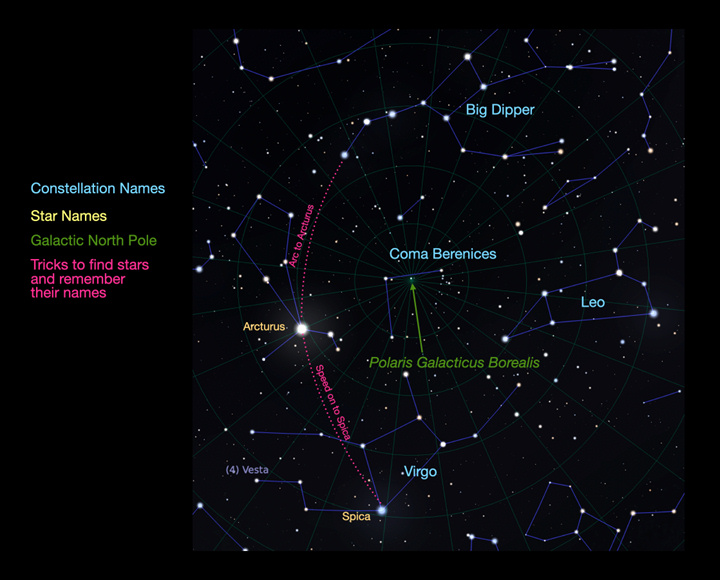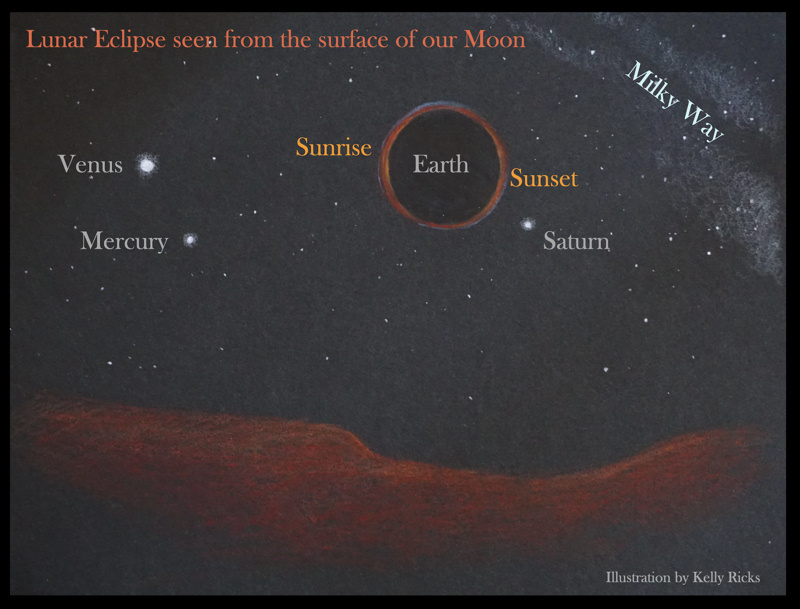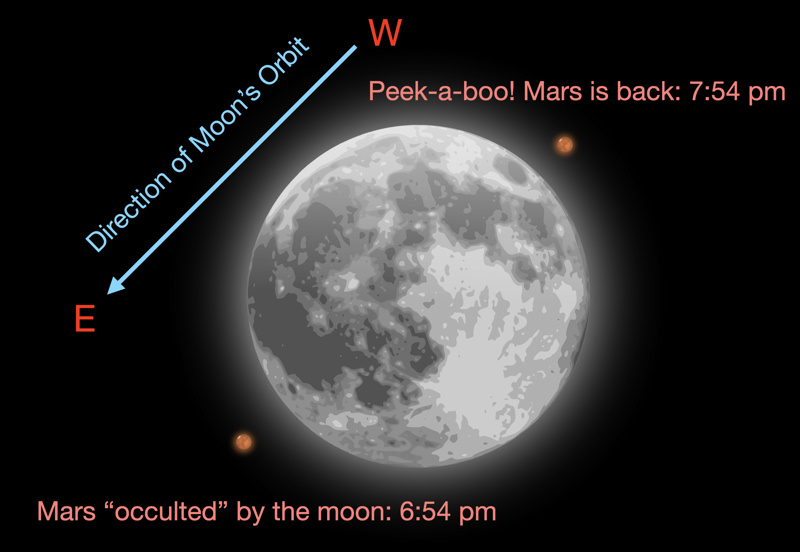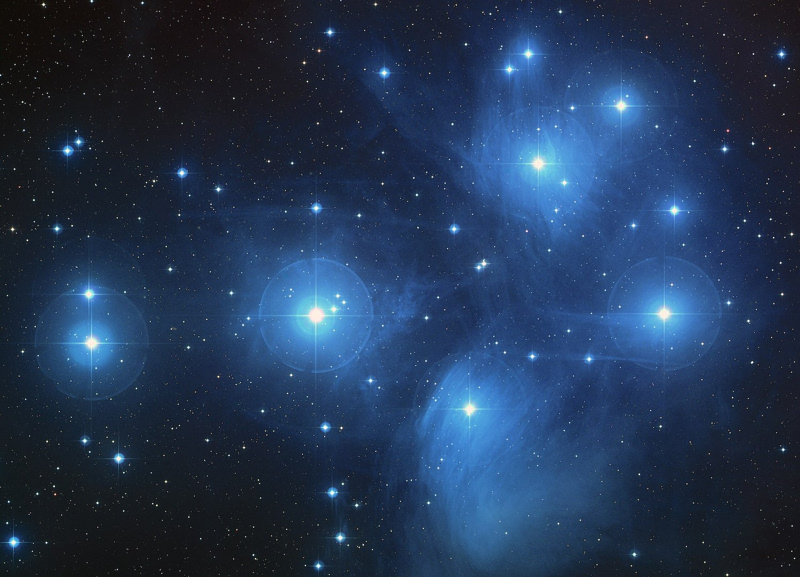Polaris Galacticus Borealis
Posted April 10, 2025.
Many of the stars and constellations that stick in our memory are those that line up with how we and our solar-system companions are oriented in space.
The constellations of the Zodiac are very well known, but anyone who has tried to decipher Ares, Aquarius, Cancer, Capricorn, Virgo, or Pisces knows that these patterns of stars are dim and don’t really resemble their intended characters. The reason these constellations are famous is because from our vantage point they happen to lie directly behind the flat plane of the solar system. From day to day, month to month, and year to year, we watch the Moon, Sun, and planets wander in front of them…and only them. Canes Venatici (The Hunting Dogs) will never catch Jupiter’s scent. You’ll never watch the moon fly with Cygnus (the Swan). And no matter how hard she might wish it, the vain queen Cassiopeia will never seize the sun for her throne. By knowing the zodiacal constellations, it’s relatively easy to orient ourselves within the solar system.
Polaris, the north star, is not particularly bright either, but like a spinning top, Earth’s northern axis happens to point straight toward it (at least within our lifetimes). As the one star that appears stationary while all others circle around it, it’s both a reliable tool for navigation, and a powerful cultural metaphor of steadfastness. High in the springtime night sky there’s another unassuming constellation that holds an anchor within: another pole star, another guidepost, and another—deeper—perspective on our orientation within the universe.

One of the few zodiacal constellations that does resemble its namesake is Leo. With a “backward question mark” as its mane, this majestic lion guards his stellar domain like a sphynx. Following close behind is a dim trio of stars: a “right angle” that almost looks like it could make a square with Leo’s tail and hind quarters. “Coma Berenices” (Berenice’s Hair) was named for Queen Berenice II of Egypt who lived in the mid 200s BC, and is the only modern constellation named for a real person. Berenice was renowned for her beautiful amber-colored hair, but when her husband King Ptolemy III went to war, she offered her tresses to Aphrodite in hopes that the goddess would bring him safely home. Ptolemy did indeed return, and Berenice’s loving sacrifice was memorialized in a constellation showcasing a long cascading cluster of stars.
| “Coma Berenices” from “Overlooked Constellations.” DeepSkyKelly.com |
Berenice’s starry “hair” is indeed beautiful, but to me its most awe-inspiring feature is that it visually anchors the Milky Way’s North Pole. That’s right. Just like Earth, our immense galaxy—with its billions of stars, planets, moons, and vast clouds of gas and dust—spins on an axis, and from our view on Earth’s northern hemisphere, that axis points to a faint star in Coma Berenices called “Polaris Galacticus Borealis,” the Galactic North Pole.
When Coma Berenices is straight overhead (around midnight in April, and 11:00pm in May) the Milky Way is not visible in the sky. This confuses—and sometimes frustrates—early-season dark-sky enthusiasts who visit our area in search of the Milky Way. But if you stand with your arms spread parallel to the ground and turn in a slow circle. The disc of our galaxy is surrounding you on all sides of the horizon! When you look up, you are looking straight out of our galaxy and toward many clusters of galaxies far beyond the Milky Way. If you continue to watch through the morning’s wee hours, you’ll see Coma Berenices and the Galactic North Pole set in the west as the brightest part of our galaxy surges above the eastern horizon before dawn.
Spring is “Galaxy Season.” The Virgo, Coma, and Leo galaxy clusters contain thousands of galaxies—dozens of which are visible with a modest-sized telescope (8-inches in diameter or more). There are so many to see in such a small area that amateur astronomers tear out their hair trying to figure out which one is which. But simply standing beneath Coma Berenices and “straight and tall in our galaxy,”* it is easy to feel part of something grand: to breathe deep within the vastness, and feel welcomed into eternity.

*From “Stars above, Earth Below” by renowned astronomer, author, and artist Tyler Nordgren

Total Lunar Eclipse
Posted March 2, 2025

The gift of fantasy has meant more to me than my talent for absorbing positive knowledge… how much sooner man could have walked on the moon… had we listened to a child’s fantasies. It is truly a pity that so many lose their gift of imagination to the steady hum of the status quo. – Albert Einstein, born March 14th, 1879
Our moon is full of stories. Ever since ever since we have looked up at our faithful celestial companion and wondered why its shape changes and how it got it’s spots. Is a hungry dog nipping at its edges? Did a rabbit throw gobs of mud onto its face? Is the moon a huge mirror reflecting Earth’s oceans and continents? All our stories about the moon are efforts to make sense of what we see and experience, and sometimes teach a lesson. Albert Einstein knew this too: science and understanding begins with wonder, imagination, observation, and investigation. And there are few things as full of wonder as an eclipse.
After thousands of years of observation scientists can now predict the movements of the moon with pinpoint precision.
- March’s full moon will be near apogee—its greatest distance from Earth—and will appear smaller than average. Some call it a “micro-moon.”
- March 13 @ 11:09 pm: the full moon will begin to enter the darkest part of Earth’s shadow (umbra).
- March 14th @ 12:26 am: totality begins. The moon is fully covered by the umbra.
- 1:31 am: totality ends as the moon starts moving back into the sunlight.
- 2:48 am: the moon will be free from the umbra
- During totality, the sun’s light spectrum will be refracted by Earth’s atmosphere till only warm colors remain, causing the moon to take on a rusty reddish hue.
This is the “Full Blood Moon.” An eerie sight in the wee hours of morning. Most old stories about eclipses imagine the moon being devoured by animals or demons, and ancient tales told under its red gaze might leave you with a sense of foreboding. But in this case, reality is even more fantastic and beautiful than myth. Let’s take a page from Einstein and imagine standing on the eclipsed moon looking back toward Earth.
You’re standing above the Sinus Medii, the “Middle Bay:” a small basalt plain at the center of our Moon’s near side. The terrain is not unlike the high volcanic plains of northeastern New Mexico…minus vegetation. An impossibly black circle surrounded by a shimmering ring of red, orange, and gold hangs high in the sky. You can see every sunrise in England, Spain, and West Africa, and every sunset over the open Pacific in a single glance. Their combined colors bathe the moon’s surface in a wash of fiery hues. Countless stars—normally invisible in the bright light of lunar day—shine like pinpoints across the sky, while Saturn, Venus, and Mercury—much brighter than surrounding stars—flank Earth’s reddened atmosphere. The lights of civilization are still too dim to make out, but somewhere down on that jet-black disc, there are a few people in northeastern New Mexico looking back in wonder.
And I almost forgot…Happy Birthday Mr. Einstein!

Where is the Milky Way Tonight?
Posted January 26, 2025
Here in northeastern New Mexico we are fortunate to have one of the darkest night skies in the nation. We’re so used to our starry sky, it’s easy to forget what a treasure it is to go outside and see the Milky Way galaxy from our own backyards. 80% of Americans today live in places where it’s impossible to see the Milky Way and some will never see it in their lifetimes. But here, all you have to do is drive a short distance from town on a moonless night and you’ll see over 5000 stars with your unaided eye. As a comparison, someone living in Chicago can only see 35! One of the reasons people visit our area is simply to experience a truly dark sky…and especially the Milky Way.
Just as we see different constellations from season to season, our view of the Milky Way changes as well. As Earth orbits the sun we see different parts of our galaxy, and it also appears in different places and orientations across the sky. In this article I’ll be talking about where and when the Milky Way can be seen between sunset and midnight—the time most of us are more likely to stargaze.
Over the next month our sky seems focused around the famous constellation of Orion. Look for the reddish star Betelgeuse (usually pronounced “beetle-juice”) that marks the mythical hunter’s left shoulder. Harry Potter fans will recognize the “movie star” in his right shoulder: Bellatrix. Following on the heels of Orion is the brightest star in our sky: Sirius, the “Dog Star:” the “heart” of the constellation Canis Major. And don’t forget Canis Minor: the “Little Dog” with a big heart named “Procyon.” The large pattern of bright stars around Orion is sometimes called the “Winter Hexagon.” These stars are largely in our galactic neighborhood. They’re close, and bright, and a few are extremely colorful. But there is still another treasure hiding among these winter constellations. One so precious, it is impossible to see in all but the darkest of skies: the “Winter Milky Way.”
The Milky Way view most of us are familiar with is the part of the galaxy we see in summer. For us in the northern hemisphere, summer is when the brightest part of the Milky Way is most visible after sunset. The dense, starry core of our galaxy is high above the southern horizon, and the spiral arms stretching up from it are rich with layer upon layer of countless stars. In winter however, we are looking directly away from that bright core and into one thin layer of stars at the very edge of our galaxy. The Winter Milky Way is faint and delicate. It floats like vapor through the Winter Hexagon and is only visible in a moonless and pristinely dark sky. Most people have no idea it’s there.
February is an excellent month for Winter Milky Way viewing. Nights with the least amount of moonlight during prime after-sunset stargazing hours are: February 1 – 4, and February 19 – 28. Drive a short distance from town about an hour after sunset. Look for Orion high in the south and see if you can identify his reddish shoulder: Betelgeuse. The Winter Milky Way runs next to Orion and right through the Winter Hexagon. For the best view you’ll need to let your eyes adapt to the darkness for a half hour or more so dress warm!
More February Star Stuff:
- Venus, Jupiter, and Mars are still bright and easy to see. Venus is in the west after sunset. At the same time, Jupiter and Mars are embedded within the Winter Hexagon, almost straight overhead.
- February 1st: Moon & Venus make a beautiful pair.
- February 9th: Moon, Mars, and two bright stars in Gemini make a beautiful quartet high overhead.
- February 16th: Venus reaches peak brightness.
- The sun will be at peak activity through 2025 and more aroura (northern lights) events are possible in our area. Up to the minute aurora forecasts can be found at www.swpc.noaa.gov/products/aurora-30-minute-forecast and many Aurora Forecast apps are available for smart phones.
Illustrations by Kelly Ricks



Playing Peekaboo with Mars
Posted January 3, 2025

Day after day we watch the sun rise and set: east to west…east to west…east to west. We watch the stars, planets, and moon rise and set: east to west…east to west…east to west. We see the sky this way because the Earth spins on its axis once per day in the opposite direction: west to east. Imagine driving from Raton to Clayton: when you come up over 19-mile hill you see Capulin Volcano appear on the eastern horizon. Then as you drive past it, the volcano recedes to the west—east to west—because you are driving west to east.
But over the course of a month, season, or year, the planets, our Moon, and our Sun actually appear to cross the sky from west to east: the opposite of what we see in a single day and night. From above, objects in our solar system orbit the sun in a counter-clockwise motion, and over long periods of time the steps of that cosmic dance come into focus.
This is easiest to notice with the moon. In the first week of this new year you may have seen the crescent moon and bright planet Venus close together right after sunset. Every night after that the moon moves further and further to the east of Venus, rising about 50 minutes later every day. On January 13th the full moon will rise at the same time the sun sets, and then 50 minutes later the next day, and the next…moving further east until it rises just before the morning sun as New Moon approaches on January 29th.
But there is a special event in this first month of 2025. The west-to-east motion of the moon will be on full display as it appears to go right over the top of Mars. This visibly red planet will disappear behind one side of the moon and then reemerge on the other exactly one hour later…peek-a-boo!
If it’s a clear sky on Monday, January 13th, go outside at 6:45 pm. You’ll see Mars (bright and noticeably orange) extremely close below the full moon. You can easily watch with your eyes alone, or pull out some binoculars or a small telescope for an even better view. The moon will get closer and closer to Mars until it “gobbles up” the planet at 6:54 pm. Mars will peek into view again on the moon’s opposite side at 7:54 pm. Watch for a while longer and you’ll see the moon continue its eastward orbit as it moves further and further past Mars.
This event—one celestial object appearing to move in front of another—is called an “occultation.” It’s relatively uncommon for the moon to occult another planet, and this time will be extra spectacular because Mars will also be as close to Earth as it gets. If you do have a telescope, you may even be able to see Mars’ icy north pole: a bright white cap against its rusty orange landscape. What a sight! Let’s hope for good clear skies!
Other things to watch for this month:
- Close pairing (conjunction) of Venus and Saturn January 16 – 19.
- Though the shower’s peak is between January 2 – 3, we’ll continue to see Quadrantid Meteors through January 16th.
- The sun will be at peak activity through 2025 and more aroura (northern lights) events are possible in our area. Up to the minute aurora forecasts can be found at www.swpc.noaa.gov/products/aurora-30-minute-forecast and many Aurora Forecast apps are available for smart phones.

A New Constellation?
Posted December 14, 2024

When days are short and temps are low it’s hard to step away from the fireplace, put down the steaming cup of cocoa, pull on a coat, hat, and gloves, and go outside. It’s even harder to do all that when it’s dark. But as we approach another Winter Solstice it’s worth remembering actress Mae West’s encouraging words, “I never said it would be easy, I only said it would be worth it.” So let’s don that winter gear and head out to enjoy the stars…you can even bring that steaming cup of cocoa if you want.
One good thing about winter’s long nights is you don’t have to stay up late to enjoy a beautiful starry sky. With late December sunsets around 4:45 PM, you can even squeeze in some stargazing before dinner. This month we have two bright planets to look for right after sunset: Venus is impossible to miss in the southwest while Jupiter, only slightly dimmer, is rising in the east. If you have a telescope or good pair of binoculars, zoom in on Jupiter to see four of its moons stretched out in a line beside it. As twilight deepens, you’ll notice a reddish star appear to the right of Jupiter. This is Aldebaran, an old red-giant, whose name means “The Follower” in Arabic. What is Aldebaran following? To find out, you’ll have to let it get a bit darker…might be a good time to refresh that cocoa.
When I was a kid, we were driving to see my grandparents in North Dakota. It was a late night in Montana’s Big Sky Country and I was mesmerized by the uncountable number of stars I could see out my window. A fuzzy patch of light caught my eye. When I looked right at it, the fuzziness instantly resolved into a cluster of 6 tiny stars. Fascinating! The only patterns of stars I knew at that time were the Big Dipper, and Orion’s Belt. This new bunch of stars reminded me a lot of the Dipper, but much, MUCH smaller. Certain that I had discovered a new constellation, I named it the “Itsy-bitsy-teeny-weenie-yellow-polka-dot-bikini Dipper.” Cheer if you still remember that song!
Years later, I learned that “my constellation” was in fact a group of stars that has been much admired all over the world and carries many names. Have you ever wondered about Subaru’s starry logo? Subaru means “unity” in Japanese and is what my Itsy-Bitsy Dipper is called in Japan. In Hawaii the stars are Makaliʻi (Little Eyes). In Wales: Tŵr Tewdws (Heap of Stars). The Berbers in the northern Sahara call them Cat iheḍ (Daughters of the Night). Many indigenous cultures around the world tell stories of women turned to stars after being chased by animals or dishonorable men, and in Greek mythology, these “Seven Sisters” are still fleeing from Orion the hunter.
In astronomical nomenclature this little group of stars is called the “Pleiades Cluster.” They are young: barely toddlers at about 100-million years old. Born together in a vast cloud of gas and dust, they drift through the galaxy and slowly separate over time as gravity and orbital dynamics lure them apart. In deep-sky photos you’ll see them surrounded by whisps of nebulosity that reflect and scatter their light in alluring shades of blue. This month (around 6:00 pm) you’ll see them hovering in the east above Jupiter and Aldebaran: the “Follower” star. If you’ve still got your binoculars handy, zoom in on that Itsy-bitsy “Dipper” and you’ll see that Aldebaran is following not “Seven Sisters,” but several dozen!
Stay warm fellow stargazers!
Other cool late-December stuff:
- Winter Solstice (longest night): December 21st
- Saturn: visible high in the south about an hour after sunset
- Mars: from Raton, look for it in the east above Johnson Mesa around 8:30 pm—very red/orange
- Milky Way: arcing high overhead from west to east (brightest in the west)
- Quadrantid Meteor Shower: start watching during the last week of December. Peak = January 2 – 3. Meteors appear to radiate from an area near the handle of the Big Dipper, but can be seen anywhere in the sky. Rate: about 120 per hour.
Included photo file: “Pleiades Star Cluster.” Public Domain. Credit: NASA, ESA, AURA/Caltech, Palomar Observatory



